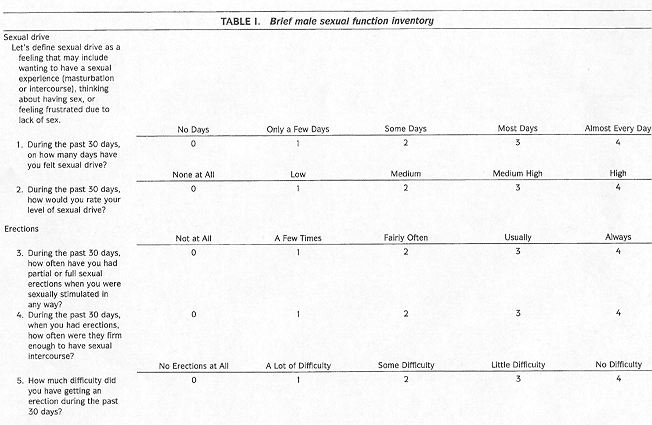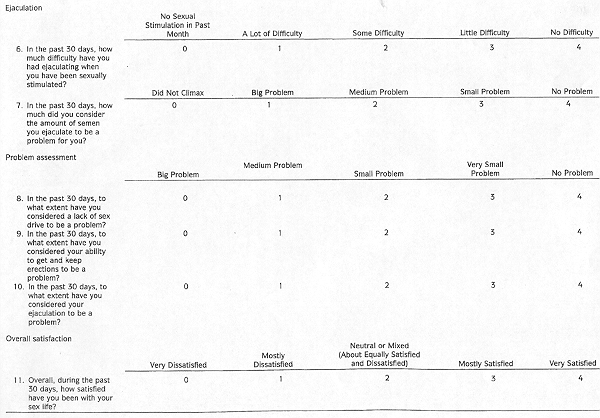
Urology, Volume 63, Issue 1: Pages 155-158, January 2004.
OBJECTIVES: To evaluate the effects of adult circumcision on sexual function in men circumcised only for religious or cosmetic reasons.
METHODS: The study group consisted of 42 male patients with a median age of 22.3 years (range 19 to 28) referred for circumcision from June 2002 to January 2003. Of the 42 men, 39 desired circumcision for religious reasons. Before circumcision, their sexual performance was evaluated using the Brief Male Sexual Function Inventory (BMSFI) and ejaculatory latency time. The BMSFI evaluation and ejaculatory latency time measurements were repeated after a postoperative interval of at least 12 weeks. The scores in the five main sections of the BMSFI and the ejaculatory latency times before and after circumcision were analyzed.
RESULTS: The differences in the mean BMSFI scores were not statistically significant in any of the five sections. However, the mean ejaculatory latency time was significantly longer after circumcision (P = 0.02).
CONCLUSIONS: Adult circumcision does not adversely affect sexual function. The increase in the ejaculatory latency time can be considered an advantage rather than a complication.
UROLOGY 63: 155-158, 2004. © 2004 Elsevier. Inc.
Circumcision is a surgical procedure performed for centuries for medical, religious, and several other reasons. Erectile impotence was one of those indications as reported in the 19th century, but a recent study has shown that circumcision can even be harmful to erectile function.2
The studies that have evaluated the effect of circumcision on sexual function were done on men circumcised for medical problems arising from their preputium, and the sexual performance of those subjects may have been affected by these pathologic findings, a drawback for the comparison of sexual function before and after circumcision.2,3
In this prospective study, we evaluated the effects of adult circumcision on sexual function in men circumcised only for religious or cosmetic reasons.
Our group consisted of 42 male patients with a median age of 22.3 years (range 19 to 28) referred for circumcision to our department between June 2002 and January 2003. Although 39 of them desired circumcision for religious reasons, the other 3 were referred for cosmetic reasons. All the subjects were heterosexual and sexually active, and none was using medication or a device to promote erections. The exclusion criteria consisted of the presence of penile skin lesions such as phimosis, balanitis, and condyloma acuminata and diseases such as diabetes mellitus or depression. Thirty-one of the subjects had a regular sexual partner and seven more had more than one partner. The partners were not interviewed. All patients provided informed consent.
Before circumcision, their sexual performance was evaluated with the Brief Male Sexual Function Inventory (BMSFI), consisting of sexual drive, erection, ejaculation, problem assessment, and overall satisfaction sections (Table I. In a 2-week period before the procedure, the subjects were asked to measure their ejaculatory latency time during at least three sessions of sexual intercourse. This was the time elapsed from intromission to ejaculation. Circumcision was performed under local anesthesia, and dorsal slit or sleeve techniques were used, depending on surgeon preference. BMSFI evaluation and ejaculatory latency time measurements were repeated after a postoperative interval of at least 12 weeks.


The scores of the five main sections of the BMSFI and the ejaculatory latency times before and after circumcision were analyzed with a paired samples t test and the significance level was set at P <0.05.
The mean scores of the five main sections of the BMSFI before and after circumcision and the mean ejaculatory latency times before and after circumcision are listed in Table II. Although the differences in the mean BMSFI scores were not statistically significant in any of the five sections, the mean ejaculatory time was significantly longer statistically after circumcision. (P = 0.02).

In Muslim and Jewish communities, circumcision is generally done in the neonatal period or during childhood, as a requirement of the religion. In the other western communities, it is mostly practiced for medical or cosmetic reasons. It has been reported that 77% of the male population born in the United States has been circumcised. In Turkey, 95 % of the population is Muslim and almost all of the male population is circumcised in childhood. However, because we practice in a military hospital, we encounter the rare subjects who were not circumcised for socioeconomic reasons in childhood. Of the 42 patients in our study, 92.8% had not been circumcised during childhood for such reasons; the others were non-Muslim patients who desired circumcision for non-religious reasons.
In a study which Collins et al. evaluated the effect of circumcision on adult men, they reported that only 1 of 15 patients were circumcised for adult reasons; all of the other patients had medical indications. According to Collins et al., this was a weakness of the study because the pathologic features of the preputium might have played an inhibitory role on sexual function. Collins et al. pointed out that subjects with a religious or cosmetic circumcision would have constituted an ideal group for such a study.
The epidermis of the glans penis is keratinized in circumcised males. These changes may result in decreased sensitivity. Masters and Johnson have shown that circumcision does not effect sensitivity. However, later, it was speculated that these changes lessen the tactile and erogenous sensitivity of the penis. Fink et al. have also shown that the sensitivity decreases in males who have undergone circumcision in adulthood. We evaluated the sensitivity as a function of the ejaculatory latency and found that in our group the ejaculatory latency time increased significantly after circumcision. This may have been a result of an increase in the subject's self-esteem, becase in the Muslim community, circumcision is traditionally considered a must for manhood.
Circumcision has been debated for decades as to its effect on sexual function. Pienkos reported that during the Korean war, soldiers asked for it, with the expectation of an increase in their sexual satisfaction. Laumann et al. observed that uncircumcised men have more sexual problems than circumcised men. In their series of 15 patients, Collins et al. found no statistically significant changes in the results in the BMSFI parameters of the subjects before and after circumcision. However, Fink et al. reported that circumcision had a negative effect on erectile function but had increased sexual satisfaction. Our study, done with an ideal group, has confirmed the result of Collins et al., and we can say with certainty that adult circumcision does not adversely affect sexual function.
The BMSFI was chosen for the present study, because it was simple for our patient to answer. The inventory has been reported to provide a reliable and valid, yet parsimonious, way to characterize sexual function. Because it does not specifically address the problem of premature ejaculation, the ejaculatory latency time was also measured.
The increase in the ejaculatory latency time can be considered an advantage rather than a complication. However, concerning the cause of that increase, in a Muslim community, the psychological influence of circumcision may be more pronounced than the organic effect.
From the Department of Urology, GATA Haydarpasa Training Hospital, Istanbul, Turkey
Reprint requests: Temucin Senkul, M.D., Department of Urology, GATA Haydarpasa Training Hospital, Üskdar, Istanbul 81327, Turkey
Submitted: June 18, 2003, accepted (with revisions): August 29, 2003
![]() Note:
Note:
The Circumcision Information and Resource Pages are a not-for-profit educational resource and library. IntactiWiki hosts this website but is not responsible for the content of this site. CIRP makes documents available without charge, for informational purposes only. The contents of this site are not intended to replace the professional medical or legal advice of a licensed practitioner.
© CIRP.org 1996-2024 | Filetree | Please visit our sponsor and host:
IntactiWiki.